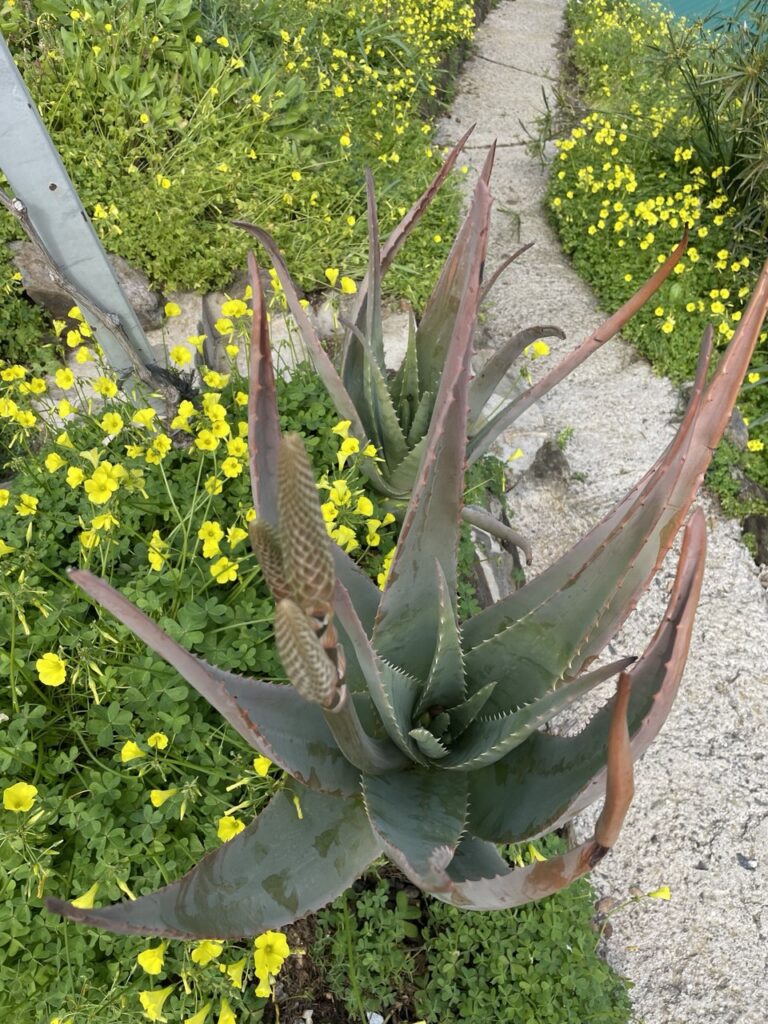
On our finca we currently grow about 200 tall aloe plants, plus all the „babies“, which they create every year. Aloe Vera is also called the „lily of the desert“ or „doctor aloe“. It is first of all a cure for skin and hair, works against inflammations and symptoms like neurodermitis, acne, eczema. It cleanses, protects and regenerates the whole organism. ( see more below on this page)
The whole leaf of the Aloe contains 5 times as many nutrients as the conserved gel. It has a cleansing and metabolic-promoting effect, specially for organs such as stomach, small and large intestines …
We offer to send you fresh Aloe Vera leaves on donation base ( plus shipping costs) and you are also welcome to do an Aloe-Vera- cure on the finca for a while. Please use the contact formular if you are interested.
For german translation please scroll down.
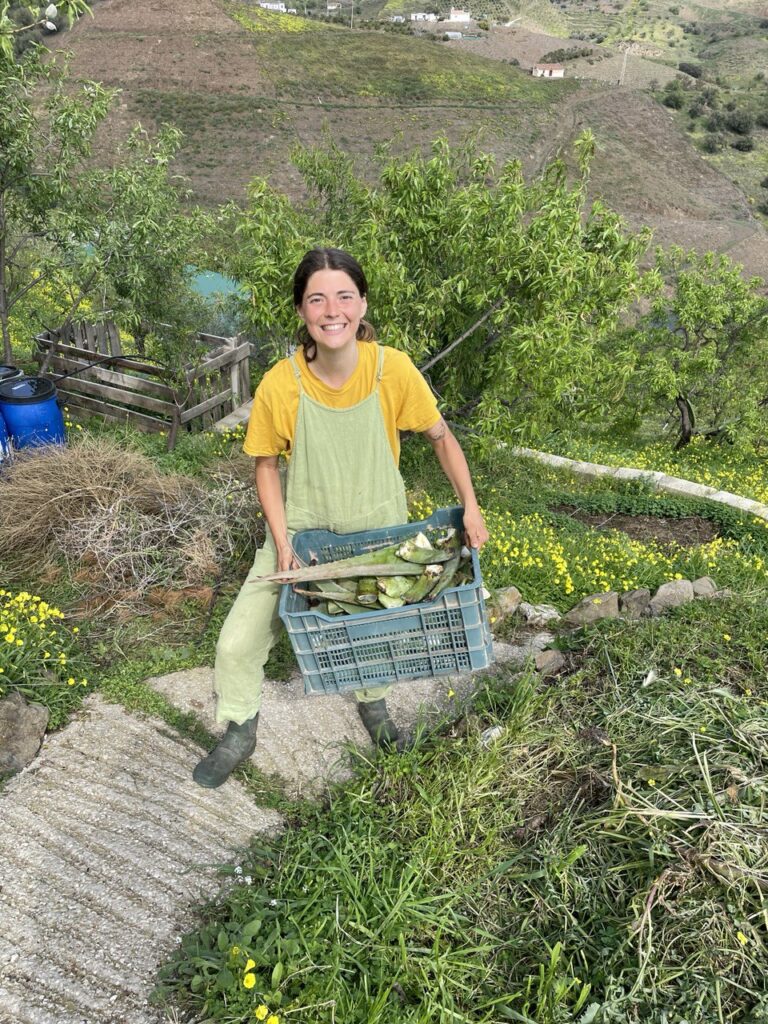
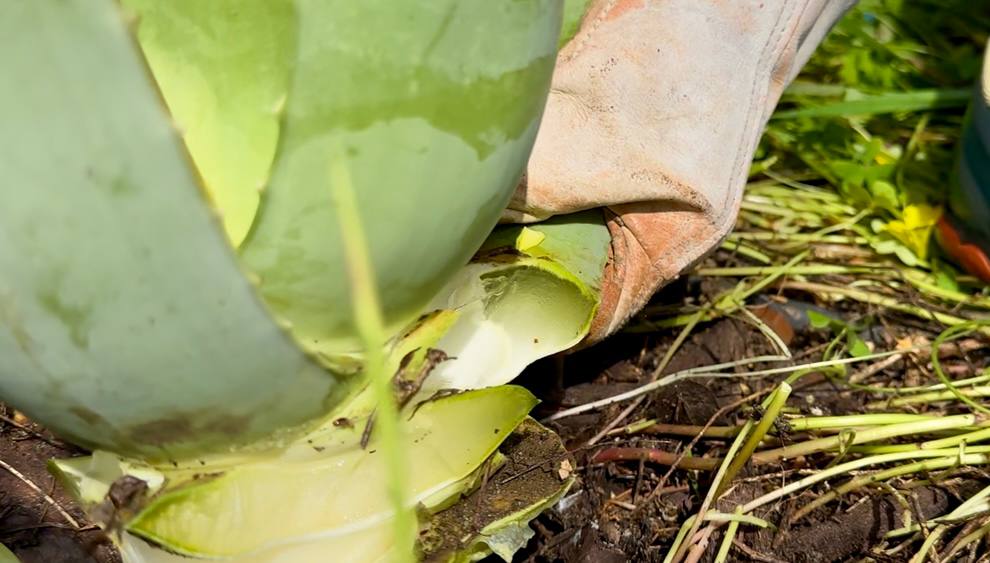
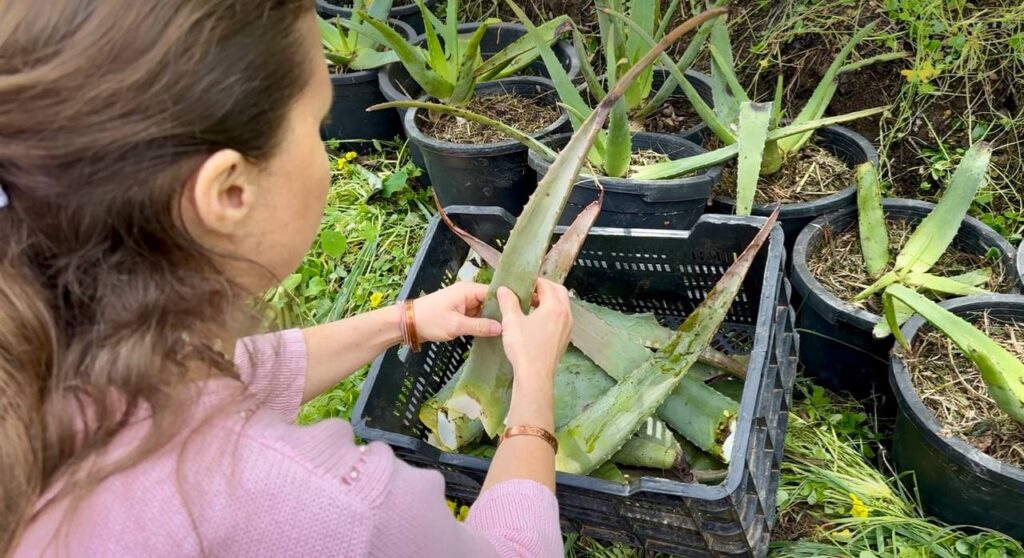
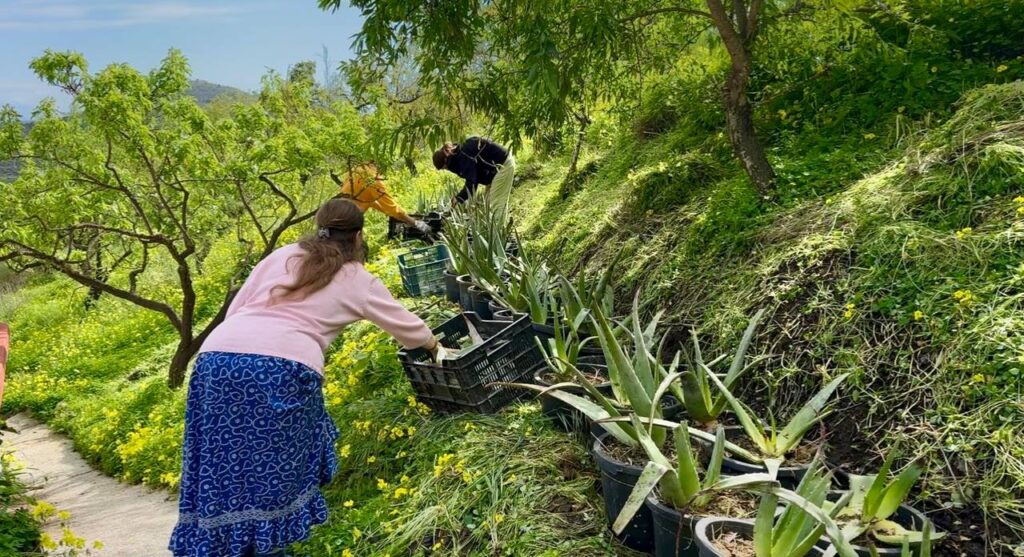
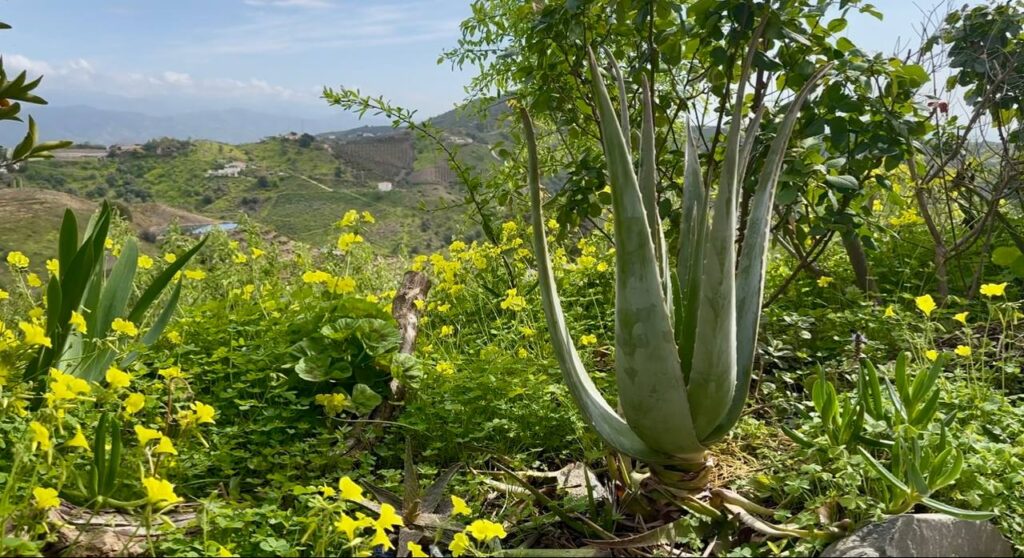
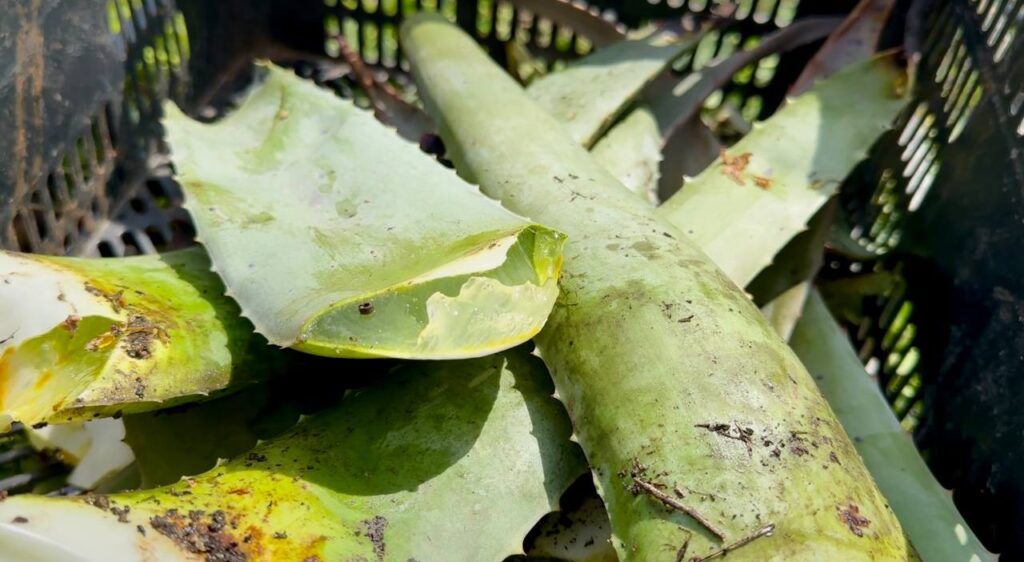
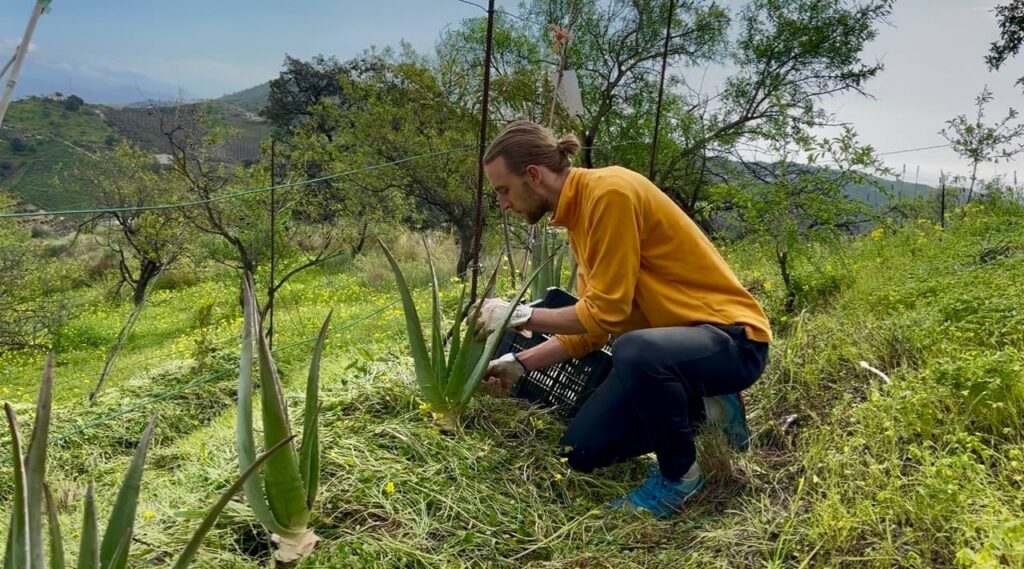
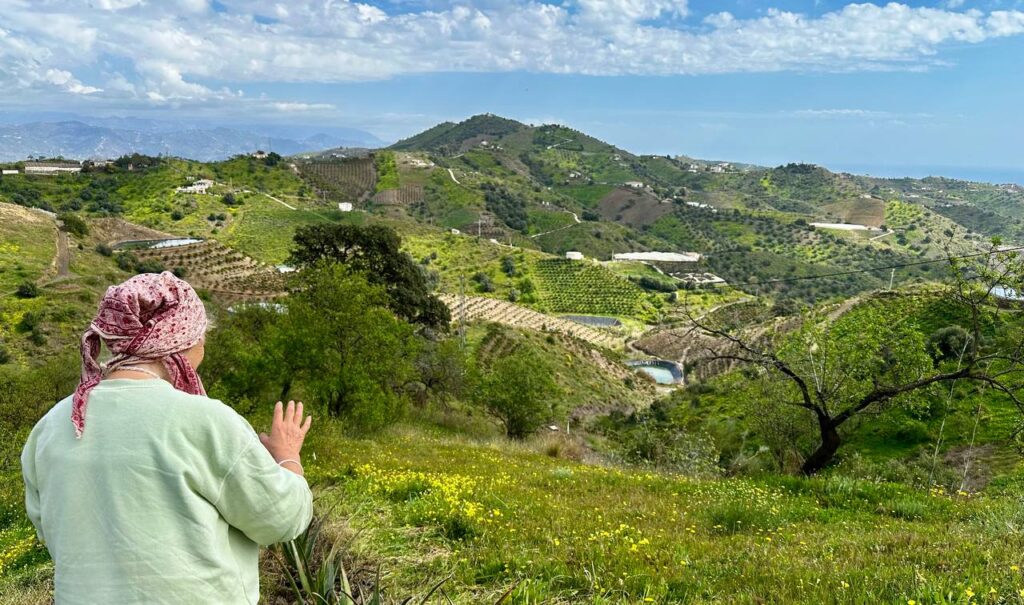
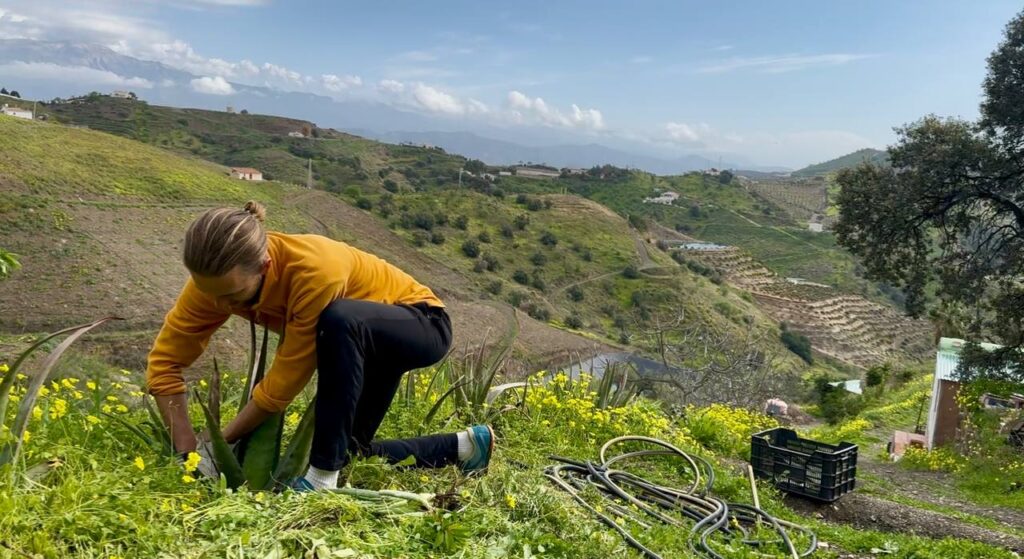
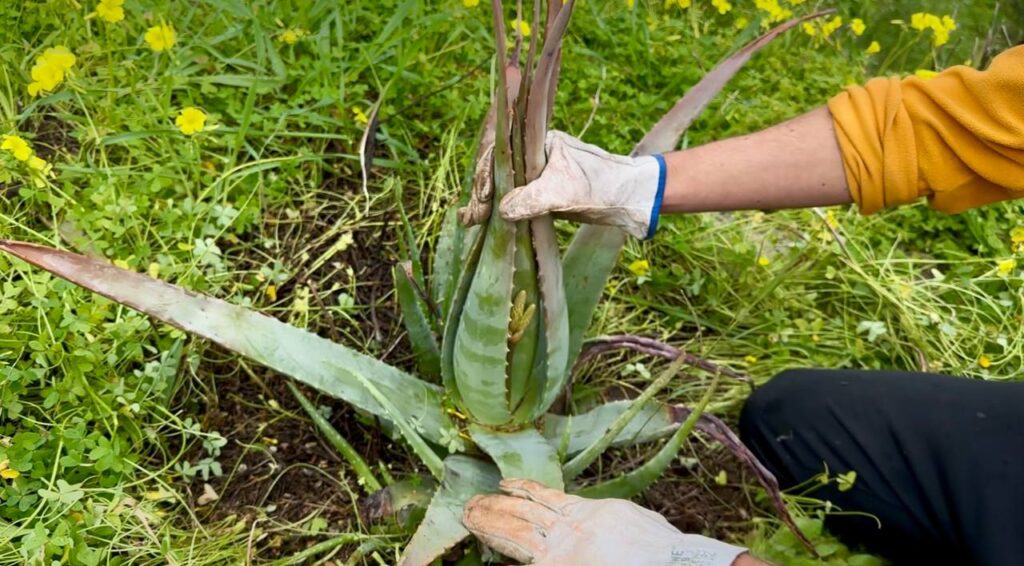
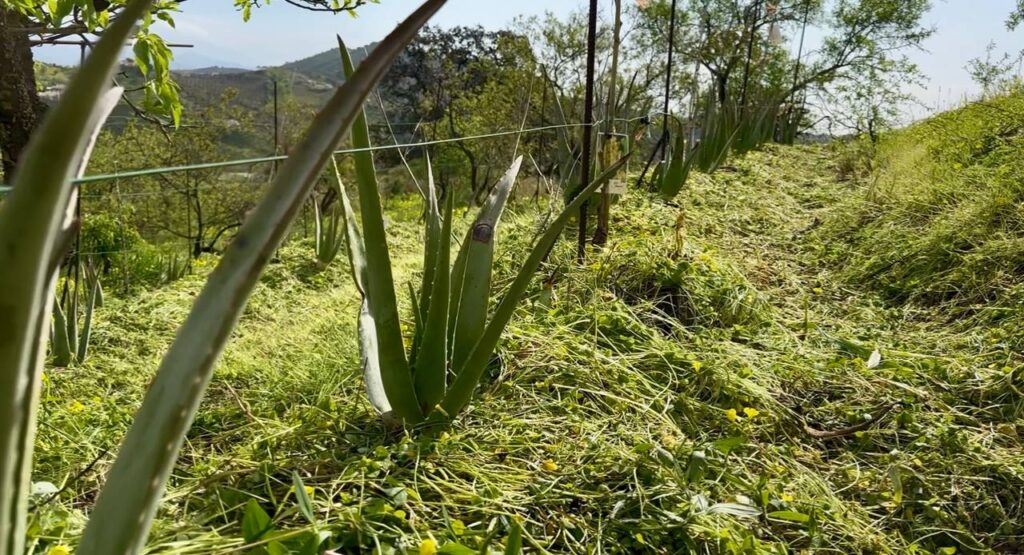
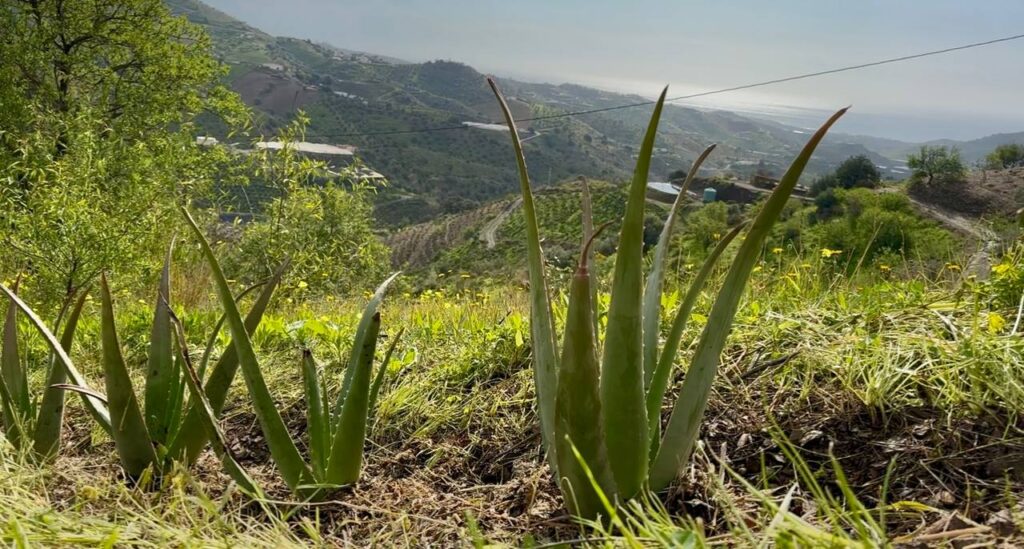
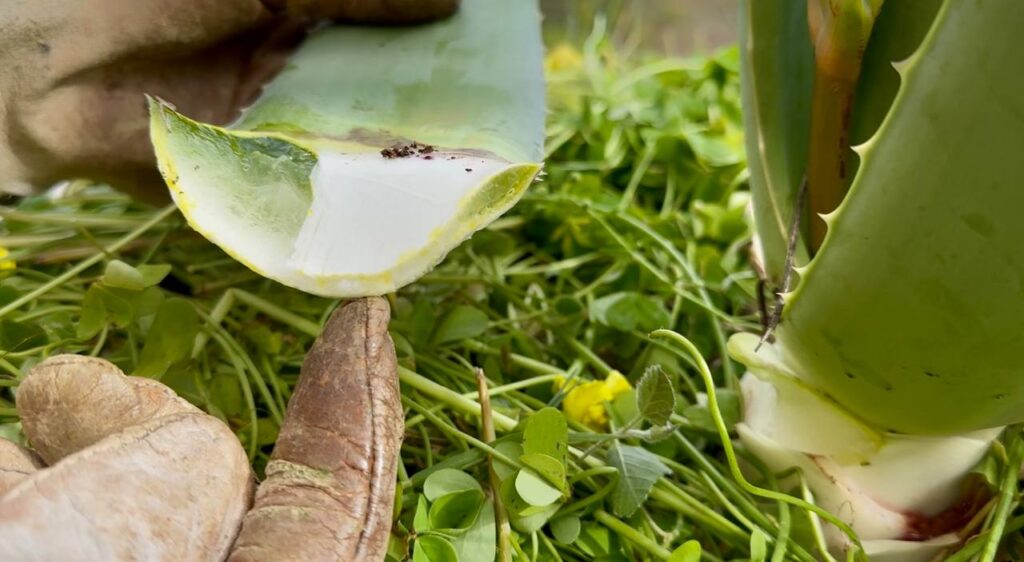
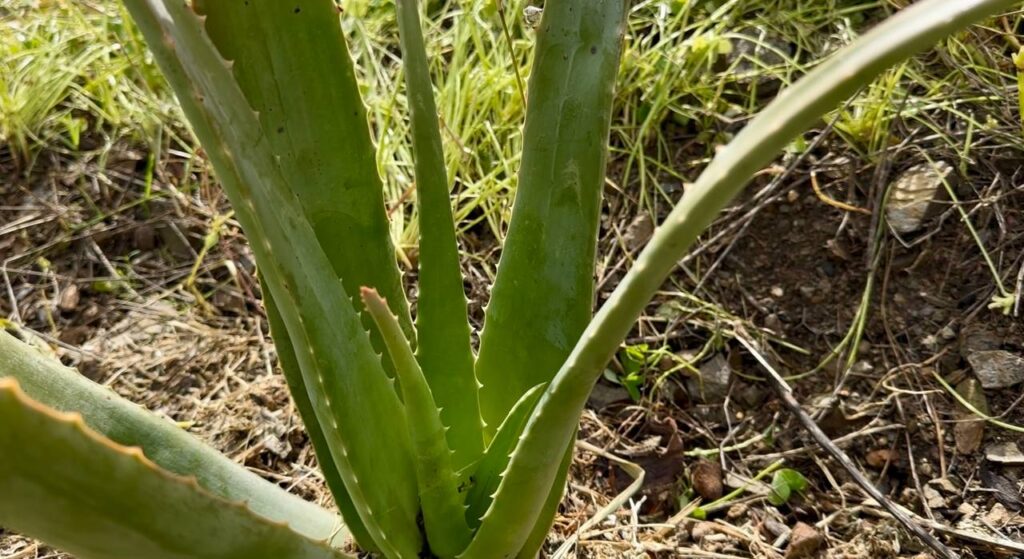
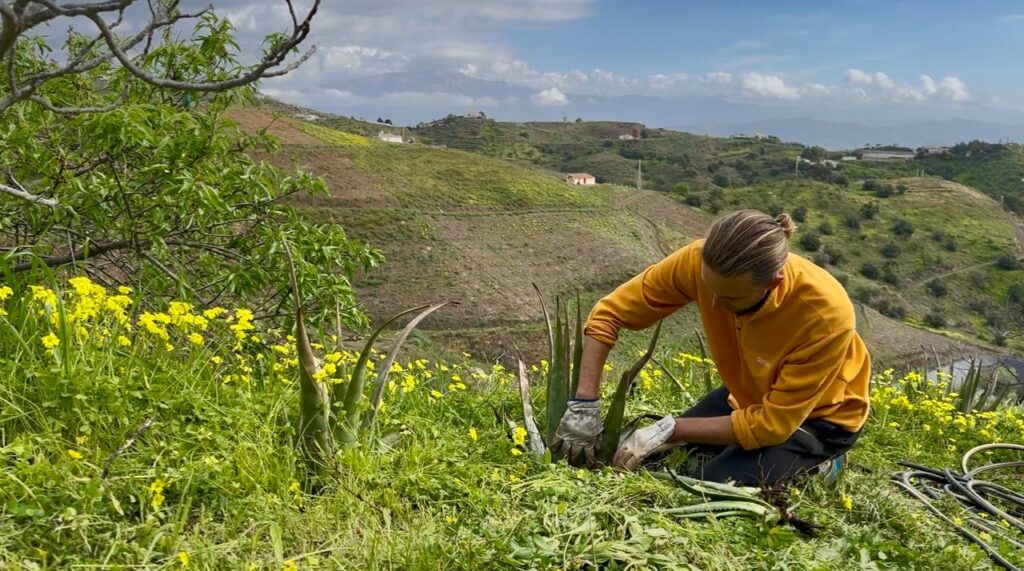
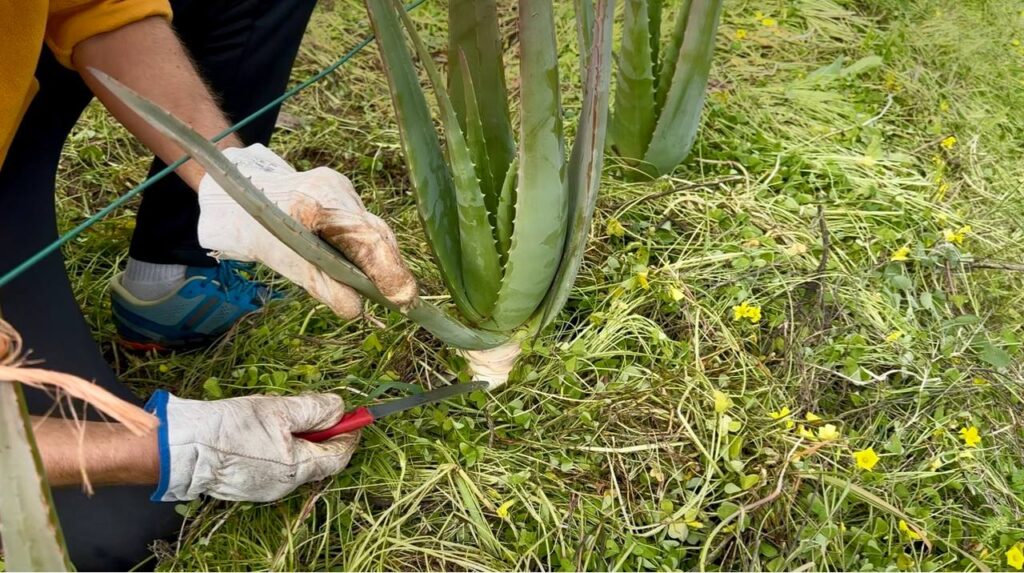
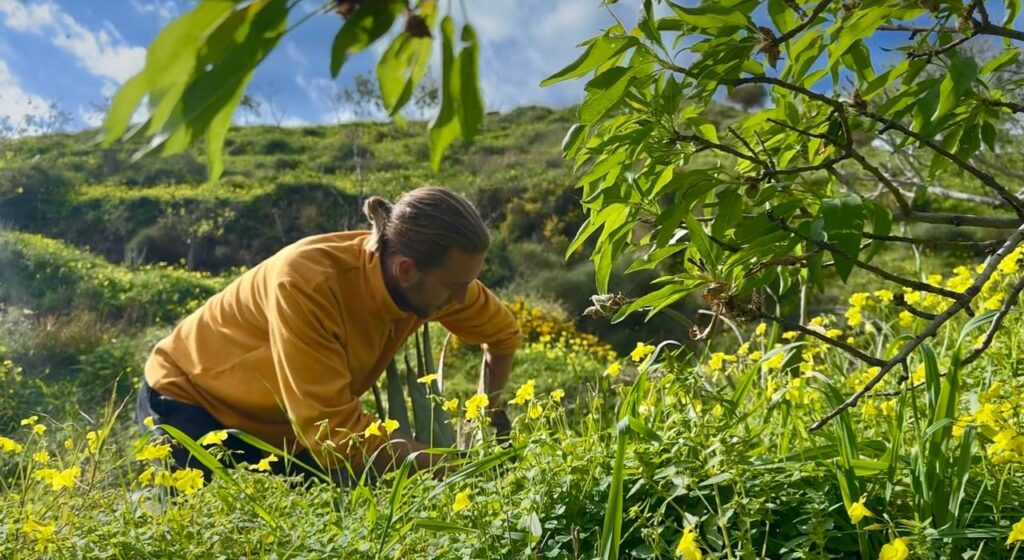
English
Botany and History
- Aloe Vera belongs to the lily family. There are about 3,000 different species, but only one, Aloe Vera Barbadensis, has been scientifically proven to have the best effects on the skin and human body.
- The plant reaches its full healing potential after 3–5 years. In ancient Egypt, Aloe Vera was considered a plant whose „blood“ granted beauty and health (also known as the Cleopatra Effect).
- Among the indigenous people of the New World, Aloe Vera was one of the 16 sacred plants, revered like deities. In Africa, nomads still call it the „Lily of the Desert“, while in America, it is known as „The Silent Healer“ or „Doctor Aloe.“
Few plants offer as many properties as Aloe Vera. Its countless physical and nutritional benefits, along with its various preventive and curative applications, make it a key ingredient in recipes, therapeutic preparations, and cosmetic products. Aloe Vera has been used for over 5,000 years. The ancient Egyptians called it the „plant of immortality“ and other civilizations, such as those of Mesopotamia, Greece, and India, also recognized its remarkable properties.
Aloe Vera has the ability to regenerate its own leaves to maintain vitality, and this same function allows us to obtain great healing and nutritional benefits from it.
What Does Aloe Vera Contain?
Aloe Vera contains 160 identified ingredients, including:
- Acemannan: The primary active ingredient, a mucopolysaccharide (a long-chain sugar). It is naturally produced in the body until puberty and must be supplemented afterward through food. Acemannan strengthens the immune system by protecting against parasites, fungi, viruses, and bacteria.
- Vitamins: A, Beta Carotene, B1 (Thiamine), B2 (Riboflavin), B3 (Niacin), B6 (Pyridoxine), B9 (Folic Acid), C, E, and H (Biotin).
- Minerals: 14 essential minerals, including Iron, Potassium, Calcium, Sodium, Magnesium, Manganese, and Zinc.
- Amino Acids: 21 amino acids, including essential ones.
- Other Components: Essential fatty acids, lignins, saponins, salicylic acid, and essential oils.
How Does Aloe Vera Help?
Aloe – The Remedy for Skin and Hair
- Heals burns, sunburns, skin ulcers, and wounds without scarring.
- Reduces inflammation and relieves symptoms of eczema, psoriasis, acne, and dermatitis.
- Penetrates all 7 layers of the skin.
- Offers natural sun protection (SPF 2-3) against short-term sun exposure.
- Nourishes, regenerates, and smooths the skin, making it especially valued by women.
- Teeth
Aloe Vera-based toothpaste improves oral hygiene and helps prevent cavities. It is also effective for inflamed gums.
Internal Benefits
- Supports the digestive system, particularly the stomach, small intestine, duodenum, and colon, by cleansing and stimulating metabolism.
- Helps with hemorrhoids and prostate issues when applied as gel pieces rectally or vaginally for fungal infections.
- Fresh Aloe Vera gel is considered a superfood by raw food enthusiasts.
Additional Benefits
- Acts as a natural deodorant by helping to eliminate sweat and toxins without causing allergic reactions.
- Prevents hair loss and dandruff, strengthens hair structure, and rejuvenates the scalp.
- Repels insects when applied to the skin.
- Soothes insect bites by disinfecting, cooling, and relieving pain.
Antiviral – Antibacterial – Antifungal Properties
- Helps with allergies by detoxifying the body and increasing tolerance to allergens.
- Treats oral infections, swollen gums, periodontal disease, and bad breath.
- Aids in vaginal yeast infections and hemorrhoids.
- Acts as a gentle laxative.
- Controls Candida overgrowth and restores gut flora.
- Relieves pain due to its active ingredients lupol, salicylic acid (found in aspirin), and magnesium.
Aloe Vera for Children
- Helps with colds, flu, allergies, infections, digestive issues, and skin conditions.
- Hyperactive children benefit from a mix of Aloe Vera gel, Blue-Green Algae, or Spirulina blended with orange or pear juice and avocado.
- The algae proteins help children develop essential neurotransmitters for better focus and calmness.
Aloe Vera in Cancer and AIDS Therapy
Cancer Support
- Boosts immune function by increasing the number of T-killer cells.
- Enhances cell membrane permeability, allowing nutrients to enter cells more easily and toxins to be expelled.
- Stimulates bone marrow activity, aiding the production of new blood cells—important for leukemia treatment.
AIDS Support
- Acemannan, Aloe Vera’s main active ingredient, detoxifies cells and strengthens the body’s resistance.
Summary
Aloe Vera cleanses, protects, and regenerates the entire body. It activates all organs, ensures optimal nutrient absorption, and supports detoxification. It enhances physical performance, improves sleep, alleviates pain, and boosts the immune system. It has shown remarkable success in cancer and AIDS treatments. Additionally, it supports heart health and helps reduce cholesterol levels. Aloe Vera is nature’s gift and a remedy for many of today’s most challenging diseases.
Why Choose Fresh Aloe Vera Leaves?
Fresh Leaves – A Natural Nutrient and Water Reservoir
- The whole Aloe leaf contains five times more active compounds than preserved Aloe Vera gel.
- The thick, fleshy leaves develop their full potency after 3–5 years and are harvested once a year by hand.
- Commercial Aloe juice can be diluted up to 100 times with water, reducing its effectiveness. Always ensure high quality when purchasing Aloe products.
Storage and Applications
- When stored properly at 10–15°C, fresh Aloe leaves can last several months without weight loss. Avoid plastic packaging, as it causes the leaf to „sweat.“
- The fresh gel can be used for burns, sunburns, insect bites, cuts, abrasions, acne, and radiation burns.
- For severe burns (2nd & 3rd degree), apply fresh Aloe leaf halves directly to the affected area.
- Stomach and Intestines. Aloe vera juice is effective in treating intestinal inflammation as it helps regulate and balance its function while neutralizing stomach acidity, making it highly recommended for gastric ulcers.
- Muscles and Joints. Numerous studies conclude that this plant helps prevent arthritis and reduces joint inflammation.
- Flu, Hepatitis, Meningitis… Aloe strengthens the immune system and, therefore, helps prevent many diseases caused by viruses or bacteria.
Recommendations
Aloe gel can be used in the preparation of juices, smoothies, or infusions. Even in small amounts, it provides excellent results. To prepare recipes without exceeding the recommended dosage, it is best to consult a medical or pharmaceutical specialist for guidance.
It can be used daily, either ingested as a preparation or applied to the skin as a cream. You can also rub a small piece of the plant’s leaf directly onto the skin.
There is no problem when applied externally, but if ingested, caution should be taken regarding the dosage. In this case, consulting a specialist in natural medicine is advisable.
Aloe can be extracted directly from the plant by removing the outer layer and taking the gelatinous part, which must be washed thoroughly before consumption. This is to remove a substance surrounding it (found between the green part of the leaf and the gel) called acíbar, which is somewhat abrasive, has an unpleasant taste, and may cause diarrhea due to its strong laxative effect.
Aloe Vera Superfood Shake Recipe
- Cut a 5 cm (2-inch) piece from an Aloe leaf.
- Remove the spiky edges, then extract the gel with a knife or spoon.
- Blend the gel with orange (or any fruit), dates (or honey), ginger, vanilla powder, and coconut milk until foamy.
- Enjoy a delicious, ice cream-like drink!
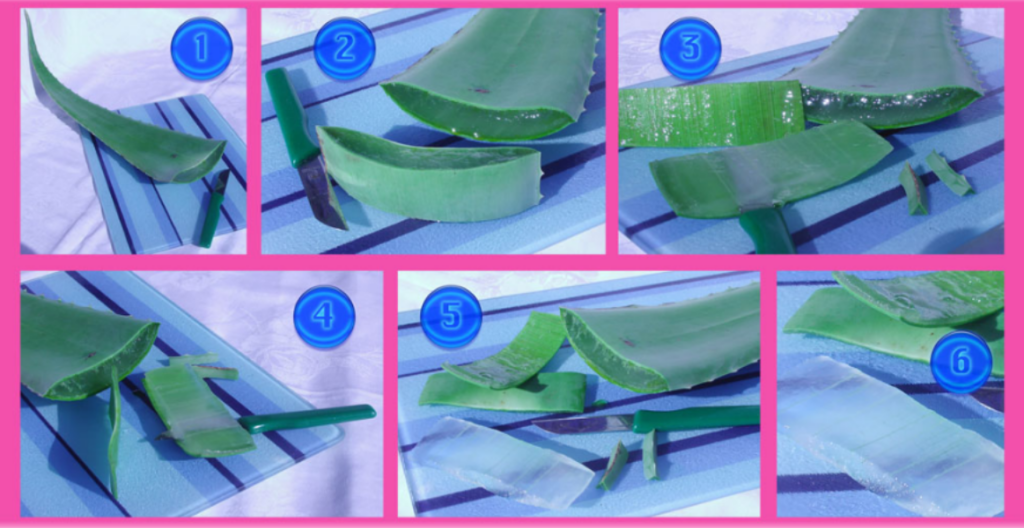
External Applications
For Hair
- Apply 100g of Aloe Vera gel, either chopped or blended, to the scalp and hair.
- Leave overnight and rinse with water in the morning.
For Skin
- Rub 5-10g of fresh Aloe Vera gel or the inside of a used Aloe leaf onto the face as a natural rejuvenation treatment.
- The gel absorbs completely, tightens the skin, and gives it a youthful appearance. Do not rinse off immediately!
Contraindications
- Internal use of fresh Aloe Vera gel is not recommended during pregnancy, as the laxative compounds near the leaf’s skin (Aloin, bitter substances) can lead to miscarriage.
breastfeeding (as it may cause diarrhea in the nursing infant), or menstruation. Children under 6 years old should not consume it.
Source of Fresh Aloe Vera Leaves
These Aloe Vera leaves originate from Finca „La Sacristia“ in Andalusia, Spain. They are organically cultivated, carefully watered, and harvested by a spiritually oriented, vegetarian community.
Deutsch
Botanik und Geschichte
• Aloe Vera gehört zur Familie der Liliengewächse. Es existieren etwa 3000 verschiedene Sorten. Nur eine davon, die „Aloe Vera Barbadensis“, verfügt nachweislich über die beste Wirkung auf die Haut und den menschlichen Organismus.
• Die Pflanze hat erst nach 3 – 5 Jahren ihre volle Heilkraft entwickelt. Im alten Ägypten galt die Aloe als Pflanze, deren „Blut“ Schönheit und Gesundheit verleiht
( = Kleopatraeffekt).
• Bei den Indianeren der Neuen Welt gehörte die Aloe zu den 16 heiligen Pflanzen, die auch dort wie Götter verehrt wurden. In Afrika nennen die Nomaden sie noch heute die „Lilie der Wüste“, bei den Amerikanern heißt sie „The silent healer“, der „stumme Heiler“ oder auch „Doktor Aloe“.
Was enthält Aloe Vera?
Es wurden bis heute 160 Inhaltsstoffe nachgewiesen:
• Der Hauptwirkstoff ist Acemannan, eines der vielen Mucopolysaccharide, eine langkettige Zuckerform.
• Acemannan wird bis zur Pubertät im Körper gebildet, danach muss es durch die Nahrung zugeführt werden. Acemannan wird in alle Zellmembrane eingelagert und bewirkt deshalb die Immunstärkung des gesamten Organismus gegen Parasiten, Pilze, Viren und Bakterien.
• Aloe Vera enthält die Vitamine A, Beta Carotin, Vitamin B1 Thiamin, B2 Riboflavin, B3 Niacin, B6 Pyridoxin, B9 Folsäure, C, E und Vitamin H Biotin.
• Außerdem 14 Mineralstoffe ( u.a. Eisen, Kalium, Calcium, Natrium, Magnesium, Mangan und Zink), 21 Aminosäuren und 4 essentielle Fettsäuren, sowie Lignine, Saponine, Salizylsäure und ätherische Öle.
Wie hilft Aloe Vera?
Aloe – d a s Heilmittel für Haut und Haar
• Aloe heilt die Haut bei stärksten Verbrennungen, Sonnenbrand , Hautgeschwüren und Wunden, ohne Narben zu hinterlassen.
• Sie wirkt entzündungshemmend und lindert Symptome bei Neurodermitis, Psoriasis (Schuppenflechte), Akne und Ekzemen.
• Aloe Vera wirkt auf der Zellebene und geht durch alle 7 Hautschichten!
• Der Lichtschutzfaktor Stärke 2-3 in Aloe Vera Gel schützt die Haut kurzfristig vor den Folgen von Sonnenbestrahlung.
• Frauen schätzen die hautnährenden, – regenerierenden und – glättenden Eigenschaft von Aloe Vera.
• Besonders auf angegriffene Verdauungsorgane wie Magen, Dünndarm, Zwölffingerdarm und Dickdarm hat das frische Blattgel reinigende und stoffwechselfördernde Wirkung.
• Bei Hämorrhoiden und Prostatabeschwerden können Gelstücke in das Rectum, bei Vaginalmykosen in die Scheide eingeführt werden.
• Das Gel aus dem Aloe Vera Frischblatt ist ein flüssiges Lebensmittel und ist bei Rohköstlern als Supernahrung ein Geheimtipp.
• Aloe hilft Schweiß und Schlackenstoffe leichter zu entlassen. Es kann als natürliches Deodorant unter den
Achseln verwendet werden und verursacht keine allergischen
Reaktionen.
• Aloe stoppt Haarausfall und Schuppenbildung, stärkt die Haarstruktur und regeneriert Haar und Kopfhaut durch Biotin (Vitamin H) und Multimineralienzufuhr.
• Zur Insektenabwehr kann man Gesicht und Körper mit Aloe einreiben.
• Insektenstiche können zur Desinfizierung, Kühlung und Schmerzlinderung mit Aloe Vera Gel bestrichen werden.
Antiviral – antibakteriell – antimykotisch
• Aloe hilft bei Allergien: Fettsäuren in Aloe Vera entgiften den Organismus und tragen so zur Erhöhung der Allergenaufnahmetoleranz bei.
• Aloe hilft bei Entzündungen im Mundraum, Zahnfleischschwellungen, Paradontose und Mundgeruch.
• Aloe hilft bei Mykosen im Vaginalbereich und Hämorrhoiden
• Aloe wirkt als sanftes Abführmittel.
• Aloe Vera hilft Candidaüberwucherungen zu kontrollieren und die natürliche Bakterienflora der Verdauungsorgane wieder aufzubauen.
• Aloe lindert die Schmerzen vieler Krankheiten durch seine Wirkstoffe Lupol, Salicylsäure (das auch in Aspirin ist) und Magnesium.
Aloe Vera für Kinder
• Für Kinder ist Aloe Gel ebenso wie bei Erwachsenen hilfreich bei Erkältungen, Grippe, Allergien, Infektionen, Verdauungsbeschwerden und Hautproblemen.
• Hyperaktive Kinder benötigen eine Kombination von Aloe Vera Gel mit „Blue Green Algen“ oder Spirulina in einem Mixgetränk mit z.B. Orangen und Birnensaft mit Avokado.
• Mit Hilfe der Algenproteine kann der kindliche Organismus die für das Gehirn wichtigen Botenstoffe aufbauen, die zur Harmonisierung beitragen.
Aloe Vera in der Krebs- und Aidstherapie
• Aloe hilft vorbeugend und begleitend bei Krebs:
• Aloe vermehrt die Anzahl der T-Killerzellen
• Aloe verstärkt die Membrandurchlässigkeit, wodurch einerseits Nährstoffe leichter in die Zellen gelangen und andererseits Stoffwechselgifte leichter ausgeschieden werden können.
• Aloe stimuliert die Knochenmarksaktivität und fördert die Bildung neuer Blutzellen, was für die Behandlung von Leukämie wichtig ist.
• Aloe hilft bei Aids: Sein Hauptwirkstoff Acemannan hat die besondere Eigenschaft, die Zellen zu reinigen und die Widerstandskräfte des gesamten Organismus zu stärken.
Zusammenfassend:
Aloe Vera reinigt, schützt und regeneriert den gesamten Organismus. Alle Organe werden aktiviert, optimal mit
Nährstoffen versorgt und durch die verbesserte Membrantätigkeit auch besser entschlackt Die Leistungsfähigkeit und Antriebskraft wird gesteigert, Schlaf normalisiert sich, Schmerzen können gelindert werden, Heilbehandlungen sprechen besser an. Das Immunsystem wird aktiviert, so dass enorme Erfolge bei Krebs- und Aidskranken zu verzeichnen sind. Herz und Kreislauf werden entlastet, Cholesterin wird abgebaut. Aloe Vera ist das Geschenk der Natur an uns alle und die Antwort auf die schwersten Krankheiten unserer Zeit.
Warum Aloe Vera als Frischblatt ?
Das Frischblatt ist ein Nährstoff- und Wasserspeicher
• Das ganze Blatt der Aloe beinhaltet etwa 5mal so viele aktive Stoffe wie das konservierte Gel.
• Die dicken, fleischigen Blätter, in denen sich erst nach drei bis fünf Jahren die begehrten Wirkstoffe voll entwickelt haben, werden einmal jährlich von Hand geerntet.
• Aloe-Saft kann bis zu 100mal mit Wasser verdünnt sein und wirkt dadurch entsprechend weniger. (Auf gute Qualität ist beim Kauf eines abgepackten Saftes also sehr zu achten!)
Das Frischblatt eignet sich besonders zur Nahrungsergänzung und zur Hautpflege.
• Bei richtiger Lagerung (10 – 15 Grad C) halten sich die Aloe Frischblätter ohne Gewichtsverlust über mehrere Monate frisch. Die Schnittfläche des Aloeblattes verschließt sich immer wieder von selbst. (Plastikverpackung ist zu vermeiden, da das Blatt in Plastik „schwitzt“.)
• Zur kosmetischen Behandlung von Verbrennungen, Verbrühungen, Sonnenbrand oder medizinischen Strahlenschäden, zur Behandlung von Akne, Insektenstichen, Abschürfungen, Schnittverletzungen usw. kann das frisch herausgeschälte Blattgel verwendet werden.
• Bei schweren Verbrennungen 2. und 3. Grades hat es sich bewährt, aufgeschnittene Blatthälften direkt auf die betroffenen Hautpartien auf zu legen.
• Als Nahrungsergänzung werden daumenbreite Stück abgeschnitten, die ungenießbare Schale wird entfernt. Das Blattinnere, das Gel, kann man in kleinen Stücken verzehren oder als Mixgetränk sehr schmackhaft zubereiten (s.u.)
Aloe Superfood-Shake Rezept:
• Ein etwa 5 cm langes Stück wird vom Aloeblatt abgeschnitten. Rechts und links des Blattes werden die Dornen entfernt. Nun kann man mit dem Messer unter der Schale das Gel herausschneiden. Den Rest des Gels kann man mit einem Löffel oder einem glatten Messer aus der Schale heraus schaben.
• Das Gel kommt in den Mixer und wird zusammen mit Orange( oder anderes Obst nach Belieben), ein paar Datteln
(oder Honig), evtl. etwas Ingwer, Vanillepulver und Kokosmilch gemixt, bis es schaumig ist.
Schmeckt einfach super, fast wie Eiscreme!

Äußerliche Anwendung:
Für die Haare:
• Ca. 100 g des Aloe Vera Gels in kleine Stücke zerschnitten oder gemixt auf Haare und Kopfhaut verteilen,
• über Nacht einwirken lassen und morgens mit klarem Wasser abspülen
Für die Haut:
• 5-10 g Frischgel oder einfach die Innenseite des für einen Shake ausgenommenen Blattes als „Verjüngungskur“ auf dem Gesicht zerreiben;
• es zieht völlig ein, strafft die Haut und schenkt ihr jugendliches Aussehen. ( nicht gleich wieder abwaschen!)
Kontraindikationen:
Das Gel aus dem Aloe Vera Frischblatt sollte während der Schwangerschaft nicht innerlich angewendet werden, da die in der Nähe der Schale enthaltenen abführenden Aloine
(Bitterstoffe) zum Fruchtabgang führen können.
Herkunft dieser Aloe Vera Frischblätter:
Diese Aloe Vera-Frischblätter stammen von der Finca
„La Sacristia“ in Andalusien/ Südspanien.
Sie werden dort von einer vegetarisch lebenden und spirituell orientierten Gemeinschaft biologisch angebaut, sorgsam bewässert und geerntet
Sehr zu empfehlen zur intensiveren Information:
Dr. John Finnegan und Reiner Otto Schmid
„Aloe Vera-das Geschenk der Natur an uns alle“
ISBN: 3-927676-10-1